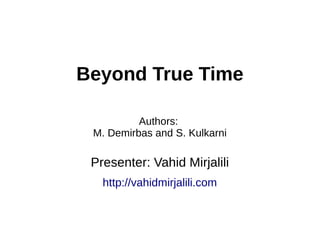Beyond TrueTime
- 1. Beyond True Time Authors: M. Demirbas and S. Kulkarni Presenter: Vahid Mirjalili http://vahidmirjalili.com
- 2. Outline ● Spanner True Time (TT) – Clock uncertainty ● Issues: – Special hardware responsible for maintaining tightly synchronized clock – Transaction delays ● Proposed Augmented-Time (AT)
- 3. Spanner & True Time (in Review) ● Spanner read and writes: – T1, T2 two transactions – If ph.T1<ph.T2, ts.T1 < ts.T2 ● TT API: – TT.now() → TT interval [earliest, latest] – Error bound: ε=(latest – earliest)/2 ● Error bound < 6ms (using special purpose time master machines) ●
- 4. Implementation A zone masterEach zone (a unit of admin. deployment) 100-1000 span servers The zone master assigns data to span servers Span servers serve data to clients ● Each span-server is responsible to 100-1000 tablets (a bag of mapping) – (key:string, timestamp:int64) → string
- 5. Paxos state machines ● Implemented on top of each tablet to support replication – Leader replica → lock table (ranges of keys to lock states) – Transaction manager → to support distribued transactions ● A Transaction involves Only 1 Paxos group: Bypass transaction manager More than 1 Paxos group: Perform 2 phase commit
- 6. Types of Transactions ‚óè Read-write ‚óè Read-only ‚óè Snapshot reads
- 7. Transaction Types ● Read-write: – Use a 2-phase locking and 2-phase commit ● Client issues a read to the leader of the appropriate group ● Acquires read locks and reads the most recent data ● 2-phase commit – Leader assign transaction timestamp when all the locks are acquired (but not released yet) si=TT.now().latest – Commit-wait for the uncertainty in TT: ● The leader blocks clients from seeing data committed by Ti until si < TT.now().earliest ● Read-only: – Assign a timestmp s_read (s_read = TT.now.latest) – Execuate a snapshot read at s_read without locking
- 8. Causality in Distributed Systems ● Approaches for ordering events: 1. Ignore wall clocks (assuming infinite uncertainty), and track events using logical clocks vector clocks: e → f iff vc.e < vc.f 2. Use a dedicated time-synchronization machine, order events by wall-clock time ● Pros and Cons: – Vector clocks: Size of VC can be too large – Spanner TrueTime: ● No communication required ● Commit-wait for uncertainty Snapshot read: Reading a consistent-cut in the past, very difficult to achieve without TT
- 9. Augmented Time (AT) ● at.j is a vector: ● at.j[k] knowledge that j has about wallclock of k ● Same update rule as VC ● Update at.j[j] by the wallclock of j – Synchronization assumption: at.j[k] cannot be less than at.j[j]-ε – No need to keep track of at.j[k] if no communication between j & k within the last ε time – Limiting the size of at.j to only those that communicated with j in the last ε time ε small TT ε large VC ε ε small TT ε small TT
- 10. Augmented Time (AT) ● Integrating AT into Spanner's tablets: – Backward compatible – (key:string, timestamp:TTstamp) → 'string , at.j'
- 11. Transactions with AT ● Read/Write Transactions: – Similar to TT execution, except that leader's timestamp is AT (a vector) instead of a single TT – No delay ● Snapshot Reads: – Similar to TT – Two cases for reading x with latest updated time tx 1. Latest update to x is older than ε → trivial case 2. x has another update within tx-ε
- 12. Snapshot Read: handling overlapping uncertainty intervals ● Issue due to no commit-wait ● Another update at t'x: – order events at tx and t'x according to AT – Identify the latest version of x – This ordering is not possible with single TT
- 13. Discussion ● AT is wait-free → higher throughout ● Hidden backchannel dependencies – Can be resolved by client-notification-wait → not reducing write throughput ● No need for dedicated GPS and atomic clocks → use NTP with moderate uncertainty
- 14. Take Home Message ● TT: – Demands highly synchronized systems (with GPS and atomic clocks) – Provides snapshot reads in the past – Has to wait for the uncertainty interval – If keeping vector clocks, size of vectors will be too large ● AT: – Size of vector is reasonably small – No need to wait for the uncertainty – Higher write throughout
- 15. Questions?



![Spanner & True Time
(in Review)
‚óè Spanner read and writes:
– T1, T2 two transactions
– If ph.T1<ph.T2, ts.T1 < ts.T2
‚óè TT API:
– TT.now() → TT interval [earliest, latest]
– Error bound: ε=(latest – earliest)/2
‚óè Error bound < 6ms (using special purpose time
master machines)
‚óè](https://image.slidesharecdn.com/beyondtruetime-150318210034-conversion-gate01/85/Beyond-TrueTime-3-320.jpg)





![Augmented Time (AT)
‚óè at.j is a vector:
‚óè at.j[k] knowledge that j has about wallclock of k
‚óè Same update rule as VC
‚óè Update at.j[j] by the wallclock of j
– Synchronization assumption: at.j[k] cannot be less than at.j[j]-ε
– No need to keep track of at.j[k] if no communication between j & k
within the last ε time
– Limiting the size of at.j to only those that communicated with j in
the last ε time
ε small
TT
ε large
VC
ε
ε small
TT
ε small
TT](https://image.slidesharecdn.com/beyondtruetime-150318210034-conversion-gate01/85/Beyond-TrueTime-9-320.jpg)





